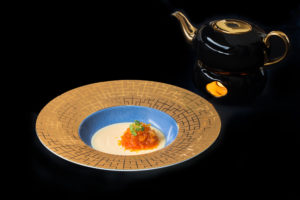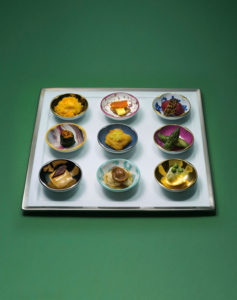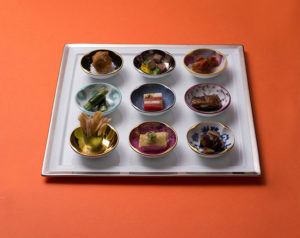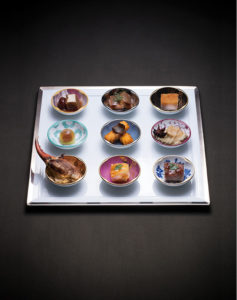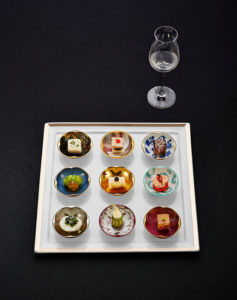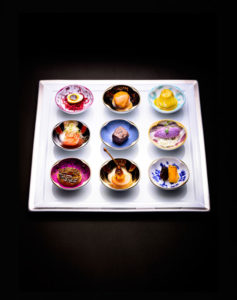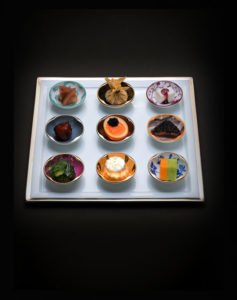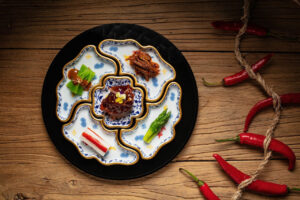
ABOUT
RUYI Gastronomy
MAGICAL
Jiu Gong Ge
-
4
-
 9
9
-
 2
2
-
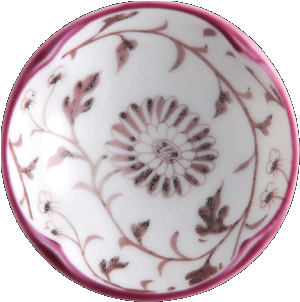 3
3
-
 5
5
-
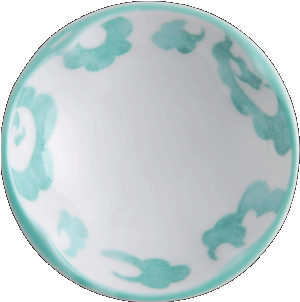 7
7
-
 8
8
-
 1
1
-
 6
6
Ho Tu Lo Shu
The magical Jiu Gong Ge (Nine Halls Diagram) first appeared in Ho Tu Lo Shu (originally from the legendary Yi Jing divination text), and is deemed a vital emblem in the Chinese study of astronomy, mathematics and feng shui. With an auspicious meaning that symbolises power and prestige, the number nine has always been viewed as an esteemed number. When applied to the culinary world, it is typically used as offering for emperors during imperial feasts. The RUYI banquet starts with the Jiu Gong Ge appetiser selection, transporting guests on a captivating gastronomic journey fit for royalty. In the Jiu Gong Ge, any straight, vertical or diagonal line adds up to the number 15, representing a harmonious universe.
Flow Sequence
The order is Five → Six → Seven → Eight → Nine → One → Two → Three → Four (Jiu Gong Banquet Dining Sequence) This dining sequence can also be arranged according to the flavour of the dishes, beginning with the light-tasting dishes and working towards the strong-tasting ones
Ming & Qing Dynasty blue and white
Qing hua (blue-and-white pottery) is one of the most commonly found decorations on Chinese porcelain ware. Inspired by Chinese traditions, LEGLE France references this historic Chinese porcelain while offering its own fresh, contemporary take on the traditional.Rose lacquer with freestyle gold
Lacquer is considered one of China's earliest luxury decorative arts. The rose-red lacquer, interspersed with splashes of gold, creates a visual joy that is as delicate as the rose.Lavish hand-painted platinum
Applied by hand to form a delicate and uniform surface, this dish reflects the artistry and rich experience of the skilled artisan. Relish in this symbol of good luck and great fortune.Late Yuan & early Ming Under Glazed Red
This technique for decorating porcelain ware has origins in the Yuan Dynasty. Underglaze red details contrast against the translucent, white porcelain, evoking purity with a fresh elegance.Late Yuan & early Ming Under Glazed Red
This technique for decorating porcelain ware has origins in the Yuan Dynasty. Translucent white contrasting with under glazed red evokes purity with a fresh elegance.Celadon with auspicious clouds
The technique of this raw glaze originated from the Longquan kilns of the Song Dynasty. Inspired by the firing process of the Qing Dynasty, the pastel colours and cloud relief of this celadon is a stunning work of art. The auspicious cloud symbols represent good luck and harmony.Suzhou Shilin stone glaze
Inspired by the Suzhou Gardens, rich layers of high-gloss and matte glaze are used to create this stunning piece.Song Dynasty Sky Blue Jun ware
Out of the famous kilns of the Song Dynasty, Jun ware, with their variants of blue, are regarded as one of the most beautiful. The multilayered blue glaze and hand-painted gold rim of the piece offers a classic touch with a contemporary twist.Black lacquer with gold splashes
The luxurious black lacquer, broken up by splashes of gold, offers a contrast between the solid black colour and freestyle gold application.Magnificent hand painted gold
Its uniform and fine surface reflects the skill of the experienced artisan. Displaying a luxurious elegance with a touch of classic and contemporary, this piece is a symbol of prosperity and luck.UNIQUE
Chinese Cuisine
MEET
Our creator
Desmond Chang, founder and head of creative resources, designed the RUYI Gastronomy experience, including the menu, pairing and tableware patterns that echo the cuisine.



